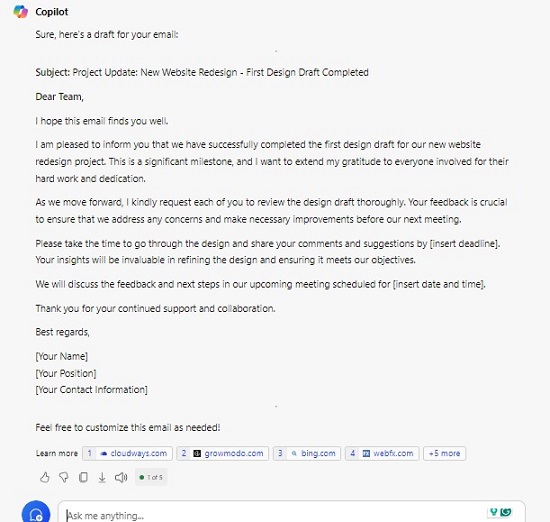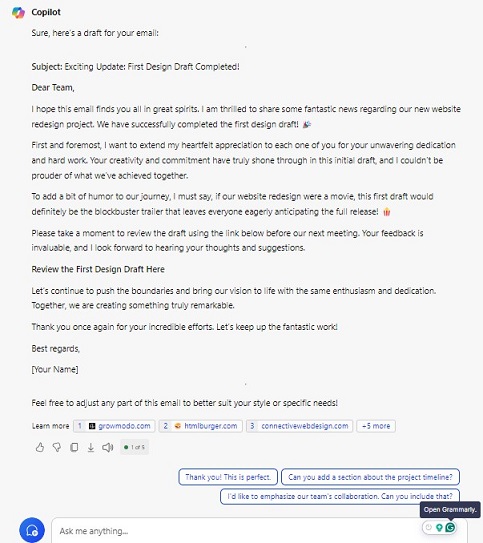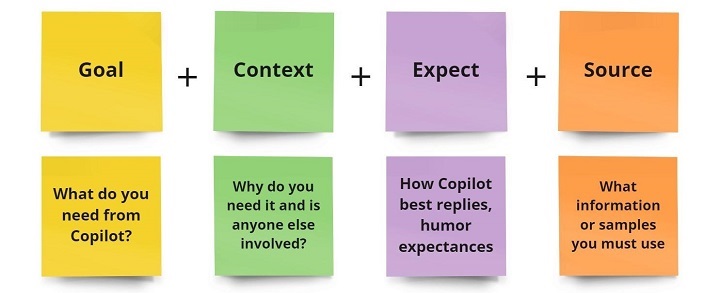
- Microsoft Copilot - Home
- Microsoft Copilot - Getting Started
- Microsoft Copilot vs Copilot Studio
- Microsoft Copilot - Licensing
- Microsoft Copilot - Beginners
- Microsoft Copilot - MS Office
- Microsoft Copilot - Professionals
- Microsoft Copilot - Prompt Engineering
- Microsoft Copilot - Lab
- Microsoft Copilot - Adoption Kit
- Microsoft Copilot - Scenario Library
- Microsoft Copilot Vs. GitHub Copilot
Microsoft Copilot - Prompt Engineering
What are prompts? Prompts are those building sentences that define the output generated by any AI model. Prompts can be really tricky when it comes to writing efficient prompts. When can you say this would be the most efficient prompt? Well, it depends upon a lot of factors. A long prompt may look complex but every long prompt is not that effective. On the other hand, some short but precise prompts can do the job perfectly.
Hence prompt engineering is the art of crafting clear, concise, and specific instructions that enable AI systems, like Microsoft Copilot, to perform tasks efficiently. In this tutorial, you will see a lot of prompts, their basic versions and how they can be modified to get the best results, especially in apps like Word, Excel, PowerPoint, and more.
Building Your First Prompt: A Step-by-Step Approach
To illustrate how you can progressively refine a prompt to generate a more accurate and useful result, lets start with a basic task: writing an email.
1. Basic Prompt Structure
A basic prompt is direct but lacks the detail needed for a refined output. Heres how a simple prompt might look −
Basic Prompt
Write an email to my team about a project update.

With this prompt, Copilot will likely create a generic email informing the team about an update. However, it may not specify which project or what kind of update is needed.
2. Refining the Basic Prompt
Now, lets add more detail to make the prompt clearer. By specifying the project name and the nature of the update, you can guide Copilot to generate a more focused result −
Refined Prompt
Write an email to my team about a project update for the new website redesign project. Mention the completion of the first design draft.

This refined prompt now points Copilot to a specific project and mentions the key progress updatethe completion of the first design draft.
Advanced Refinement: Adding Expectations and Tone
At this stage, you can enhance the email further by specifying the tone and expectations. Perhaps you want the email to be formal and include the next steps −
Advanced Prompt
Write a formal email to my team about a project update for the new website redesign project. Mention the completion of the first design draft and ask the team to review it before the next meeting.

Now, the email is not only providing the update but also clearly requesting an action from the team, while maintaining a formal tone.
Ultimate Refinement: Adding Creativity, Humour, Acknowledgement, and References
Finally, we can take the prompt to the next level by adding elements like acknowledgement of team efforts and a link to the document, making the email more engaging and informative −
Final Prompt
Write a formal and appreciative email to my team about a project update for the new website redesign project. Mention the completion of the first design draft, add some humour, acknowledge the teams hard work, and include a link to the draft for review before the next meeting. End the email by motivating the team to continue with the same dedication.

This final version produces a highly personalised, engaging email that not only conveys the necessary information but also motivates the team and encourages their input, resulting in well-rounded communication.
Prompt Architecture You Need To Follow

Prompt Engineering in Different Microsoft 365 Apps
Each Microsoft app requires slightly different approaches to prompt engineering. Below are examples across Word, Excel, and PowerPoint.
Prompt Engineering in Word
Lets consider a simple task in Microsoft Word. You want to generate a formal letter.
Basic Prompt
Create a business letter.
This will yield a generic letter. By adding more context, you can achieve a more tailored result −
Intermediate Prompt
Create a formal business letter requesting a meeting.
Lets further refine it with more details −
Advanced Prompt
Create a formal business letter requesting a meeting, and include a reference to the recent project report.
Finally, to make the letter engaging, add a touch of humour −
Final Prompt
Create a formal business letter requesting a meeting, include a polite reference to the recent project report, and end with a witty remark about improving collaboration efficiency.
Prompt Engineering in Excel
For Excel, prompts often involve data analysis and visualisation.
Basic Prompt
Create a pie chart of sales data.
To make the result more meaningful, add specific details −
Intermediate Prompt
Create a pie chart of sales data for Q1, highlighting the top-performing products.
For deeper insights, add comparative data −
Advanced Prompt
Create a pie chart of sales data for Q1, highlighting top-performing products, and compare it with the previous quarters sales.
The final refinement can include projections or footnotes −
Final Prompt
Create a pie chart of Q1 sales data, highlight top-performing products, compare with the previous quarter, and add a footnote on projected trends for Q2.
Prompt Engineering in PowerPoint
PowerPoint prompts are used for generating presentations. Here's how to refine them step by step.
Basic Prompt
Create a presentation.
Add more context for better results −
Intermediate Prompt
Create a 5-slide presentation on the new marketing strategy.
Next, refine it by specifying what kind of visual aids you need −
Advanced Prompt
Create a 5-slide presentation on the new marketing strategy, and include an engaging chart on customer demographics.
To make the presentation more creative, consider adding humour or transitions −
Final Prompt
Create a 5-slide presentation on the new marketing strategy, include a chart on customer demographics, and add humour to the slide transitions.
Advanced Techniques for Writing Prompts
Multi-Step Prompts
Instead of asking Copilot to perform one large task, break it down into smaller, manageable steps.
Basic Prompt
Generate a report.
This can be unclear, so lets refine it −
Intermediate Prompt
Generate a monthly sales report, and include data on new customers.
You can now add comparisons and insights −
Advanced Prompt
Generate a monthly sales report, include data on new customers and compare with the last quarter.
For a more comprehensive result −
Final Prompt
Generate a monthly sales report, include data on new customers, compare with the last quarter, and add a footnote on customer retention strategies.
Conditional Prompts and Follow-Ups
Copilot can also handle conditional instructions −
Basic Prompt
If sales increase, show a graph, otherwise display a table.
Refining this −
Intermediate Prompt
If sales increase, show a graph with a product-wise breakdown, otherwise display a table with region-wise sales.
Dynamic Data and Referencing
Prompts can also reference dynamic data, such as pulling information from external sources or updating in real time.
Example
Fetch data from the last quarterly report and generate a sales summary comparing regional performance, adding predictions for the next quarter based on current trends.
Common Mistakes in Prompt Writing
Overloading Prompts
Overloading prompts with too many tasks can confuse Copilot.
- Overloaded Prompt − "Create a document summarising this data, then create a chart, and email it to all team members." Break it down for clarity.
- Refined Prompt − "Summarise this data first, then create a chart, and finally, draft an email to all team members."
Avoiding Ambiguity
When writing prompts, it's crucial to avoid ambiguity. Vague instructions can lead to unclear results. For example −
Ambiguous Prompt − "Analyse the data."
Without context or detail, Copilot may not know whether you want a simple overview or an in-depth analysis.
Refined Prompt − "Analyse the data and highlight the sales growth by region over the last quarter."
Now, Copilot can get more clear on what matters, avoiding unnecessary information or confusion.
Conclusion
Effective prompt engineering is about starting with clear, simple instructions and refining them to include context, expectations, and creativity. By following this step-by-step approach, you can maximise Microsoft Copilots potential and generate accurate, high-quality results. Practice with different prompts in various Microsoft apps to become proficient in crafting the best instructions for your needs.